weight Lancia Delta 2010 Owner handbook (in English)
[x] Cancel search | Manufacturer: LANCIA, Model Year: 2010, Model line: Delta, Model: Lancia Delta 2010Pages: 276, PDF Size: 5.31 MB
Page 151 of 276
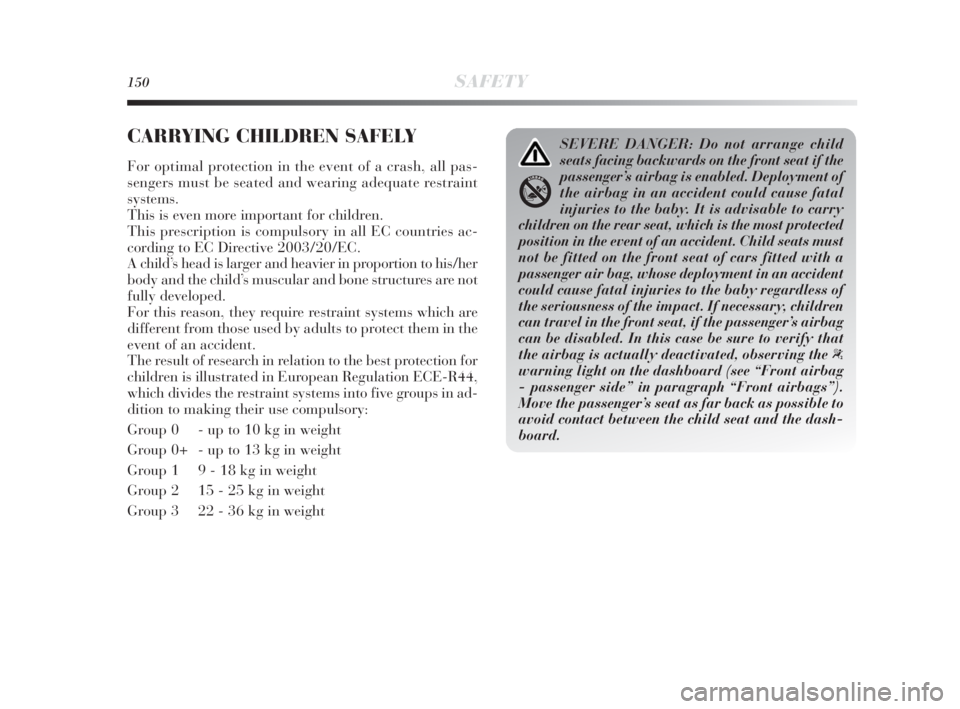
150SAFETY
CARRYING CHILDREN SAFELY
For optimal protection in the event of a crash, all pas-
sengers must be seated and wearing adequate restraint
systems.
This is even more important for children.
This prescription is compulsory in all EC countries ac-
cording to EC Directive 2003/20/EC.
A child’s head is larger and heavier in proportion to his/her
body and the child’s muscular and bone structures are not
fully developed.
For this reason, they require restraint systems which are
different from those used by adults to protect them in the
event of an accident.
The result of research in relation to the best protection for
children is illustrated in European Regulation ECE-R44,
which divides the restraint systems into five groups in ad-
dition to making their use compulsory:
Group 0 - up to 10 kg in weight
Group 0+ - up to 13 kg in weight
Group 1 9 - 18 kg in weight
Group 2 15 - 25 kg in weight
Group 3 22 - 36 kg in weight
SEVERE DANGER: Do not arrange child
seats facing backwards on the front seat if the
passenger’s airbag is enabled. Deployment of
the airbag in an accident could cause fatal
injuries to the baby. It is advisable to carry
children on the rear seat, which is the most protected
position in the event of an accident. Child seats must
not be fitted on the front seat of cars fitted with a
passenger air bag, whose deployment in an accident
could cause fatal injuries to the baby regardless of
the seriousness of the impact. If necessary, children
can travel in the front seat, if the passenger’s airbag
can be disabled. In this case be sure to verify that
the airbag is actually deactivated, observing the
“
warning light on the dashboard (see “Front airbag
- passenger side” in paragraph “Front airbags”).
Move the passenger’s seat as far back as possible to
avoid contact between the child seat and the dash-
board.
143-164 Delta 4ed gb 12-02-2010 10:20 Pagina 150
Page 152 of 276
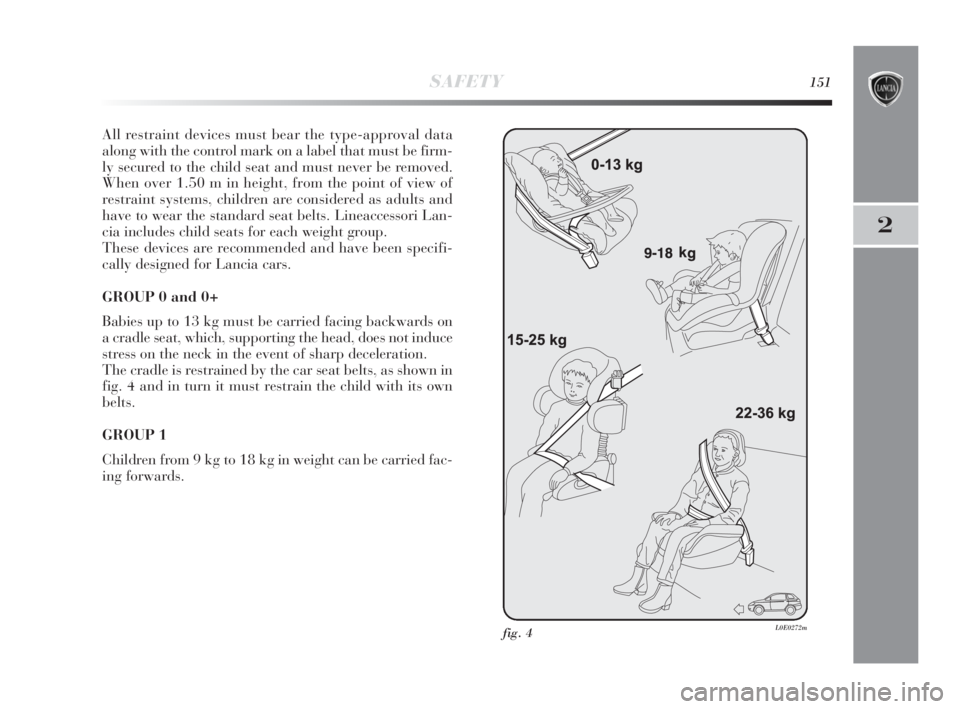
SAFETY151
2
All restraint devices must bear the type-approval data
along with the control mark on a label that must be firm-
ly secured to the child seat and must never be removed.
When over 1.50 m in height, from the point of view of
restraint systems, children are considered as adults and
have to wear the standard seat belts. Lineaccessori Lan-
cia includes child seats for each weight group.
These devices are recommended and have been specifi-
cally designed for Lancia cars.
GROUP 0 and 0+
Babies up to 13 kg must be carried facing backwards on
a cradle seat, which, supporting the head, does not induce
stress on the neck in the event of sharp deceleration.
The cradle is restrained by the car seat belts, as shown in
fig. 4 and in turn it must restrain the child with its own
belts.
GROUP 1
Children from 9 kg to 18 kg in weight can be carried fac-
ing forwards.
fig. 4L0E0272m
143-164 Delta 4ed gb 12-02-2010 10:20 Pagina 151
Page 154 of 276
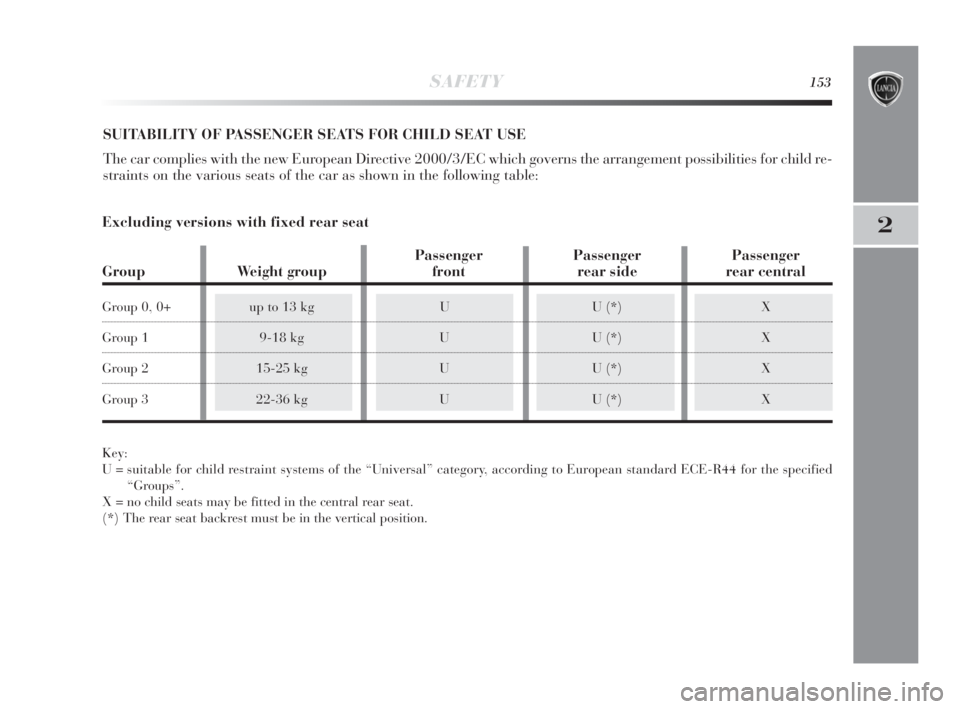
SAFETY153
2
SUITABILITY OF PASSENGER SEATS FOR CHILD SEAT USE
The car complies with the new European Directive 2000/3/EC which governs the arrangement possibilities for child re-
straints on the various seats of the car as shown in the following table:
Key:
U = suitable for child restraint systems of the “Universal” category, according to European standard ECE-R44 for the specified
“Groups”.
X = no child seats may be fitted in the central rear seat.
(*) The rear seat backrest must be in the vertical position.
Passenger Passenger Passenger
Group Weight group front rear side rear central
Group 0, 0+ up to 13 kg U U (*) X
Group 1 9-18 kg U U (*) X
Group 2 15-25 kg U U (*) X
Group 3 22-36 kg U U (*) X
Excluding versions with fixed rear seat
143-164 Delta 4ed gb 12-02-2010 10:20 Pagina 153
Page 155 of 276

154SAFETY
Only for versions with fixed rear seat
Key:
U = suitable for child restraint systems of the “Universal” category, according to European standard ECE-R44 for the specified
“Groups”.
X = corresponds to the rear side seat (driver's side) not possible to fit any type child seats.
Passenger Passenger
Passenger rear side Passenger rear side
Group Weight group front (passenger side) read central (driver's side)
Group 0, 0+ up to 13 kg U U U X
Group 1 9-18 kg U U U X
Group 2 15-25 kg U U U X
Group 3 22-36 kg U U U X
143-164 Delta 4ed gb 12-02-2010 10:20 Pagina 154
Page 156 of 276
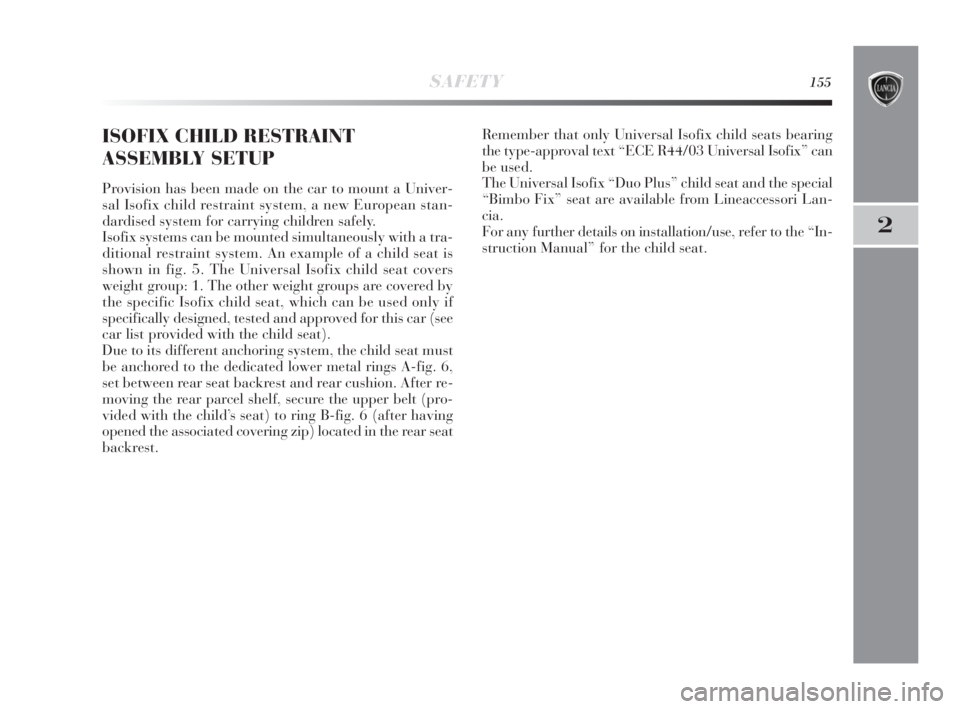
SAFETY155
2
ISOFIX CHILD RESTRAINT
ASSEMBLY SETUP
Provision has been made on the car to mount a Univer-
sal Isofix child restraint system, a new European stan-
dardised system for carrying children safely.
Isofix systems can be mounted simultaneously with a tra-
ditional restraint system. An example of a child seat is
shown in fig. 5. The Universal Isofix child seat covers
weight group: 1. The other weight groups are covered by
the specific Isofix child seat, which can be used only if
specifically designed, tested and approved for this car (see
car list provided with the child seat).
Due to its different anchoring system, the child seat must
be anchored to the dedicated lower metal rings A-fig. 6,
set between rear seat backrest and rear cushion. After re-
moving the rear parcel shelf, secure the upper belt (pro-
vided with the child’s seat) to ring B-fig. 6 (after having
opened the associated covering zip) located in the rear seat
backrest. Remember that only Universal Isofix child seats bearing
the type-approval text “ECE R44/03 Universal Isofix” can
be used.
The Universal Isofix “Duo Plus” child seat and the special
“Bimbo Fix” seat are available from Lineaccessori Lan-
cia.
For any further details on installation/use, refer to the “In-
struction Manual” for the child seat.
143-164 Delta 4ed gb 12-02-2010 10:20 Pagina 155
Page 158 of 276

SAFETY157
2
PASSENGER SEAT COMPLIANCE WITH REGULATIONS ON UNIVERSAL ISOFIX CHILD SEAT USE
The table below shows the different installation possibilities of Isofix restraint systems on seats fitted with Isofix fas-
teners in compliance with European standard ECE 16.
IUF: suitable for Isofix child restraint systems to be set facing forwards, universal class (fitted with third upper fastener), ap-
proved for the relevant weight group.
IL: suitable for special child restraint systems, specific Isofix type, and type-approved for this type of car.
X: Isofix position not suitable for Isofix child restraint systems in this weight group and/or size.
Weight group Orientation Grade Isofix position
child seat Isofix size side rear
Portable cradle Side F-G IL
Group 0 up to 10 kg Facing backwards E IL
Facing backwards E IL
Group 0 + up to 13 kg Facing backwards D IL
Facing backwards C IL
Facing backwards D IL
Facing backwards C IL
Group 1 from 9 to 18 kg Facing forwards B IUF
Facing forwards B1 IUF
Facing forwards A IUF
143-164 Delta 4ed gb 12-02-2010 10:20 Pagina 157
Page 171 of 276
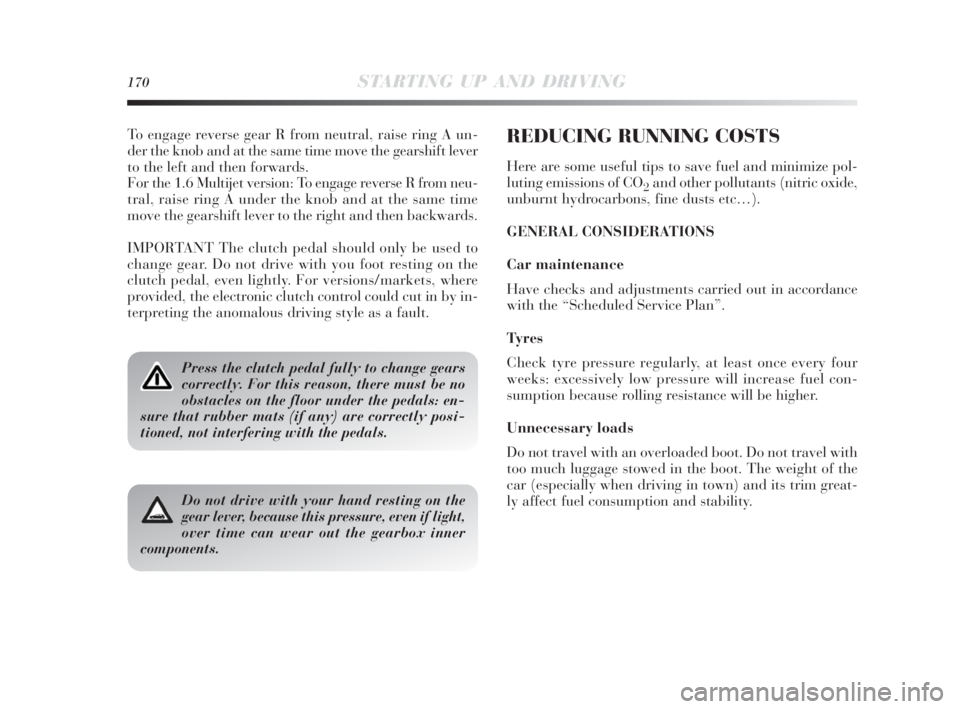
170STARTING UP AND DRIVING
To engage reverse gear R from neutral, raise ring A un-
der the knob and at the same time move the gearshift lever
to the left and then forwards.
For the 1.6 Multijet version: To engage reverse R from neu-
tral, raise ring A under the knob and at the same time
move the gearshift lever to the right and then backwards.
IMPORTANT The clutch pedal should only be used to
change gear. Do not drive with you foot resting on the
clutch pedal, even lightly. For versions/markets, where
provided, the electronic clutch control could cut in by in-
terpreting the anomalous driving style as a fault.
Press the clutch pedal fully to change gears
correctly. For this reason, there must be no
obstacles on the floor under the pedals: en-
sure that rubber mats (if any) are correctly posi-
tioned, not interfering with the pedals.
Do not drive with your hand resting on the
gear lever, because this pressure, even if light,
over time can wear out the gearbox inner
components.
REDUCING RUNNING COSTS
Here are some useful tips to save fuel and minimize pol-
luting emissions of CO
2and other pollutants (nitric oxide,
unburnt hydrocarbons, fine dusts etc…).
GENERAL CONSIDERATIONS
Car maintenance
Have checks and adjustments carried out in accordance
with the “Scheduled Service Plan”.
Tyres
Check tyre pressure regularly, at least once every four
weeks: excessively low pressure will increase fuel con-
sumption because rolling resistance will be higher.
Unnecessary loads
Do not travel with an overloaded boot. Do not travel with
too much luggage stowed in the boot. The weight of the
car (especially when driving in town) and its trim great-
ly affect fuel consumption and stability.
165-174 Delta 3ed gb 11-11-2009 12:10 Pagina 170
Page 173 of 276
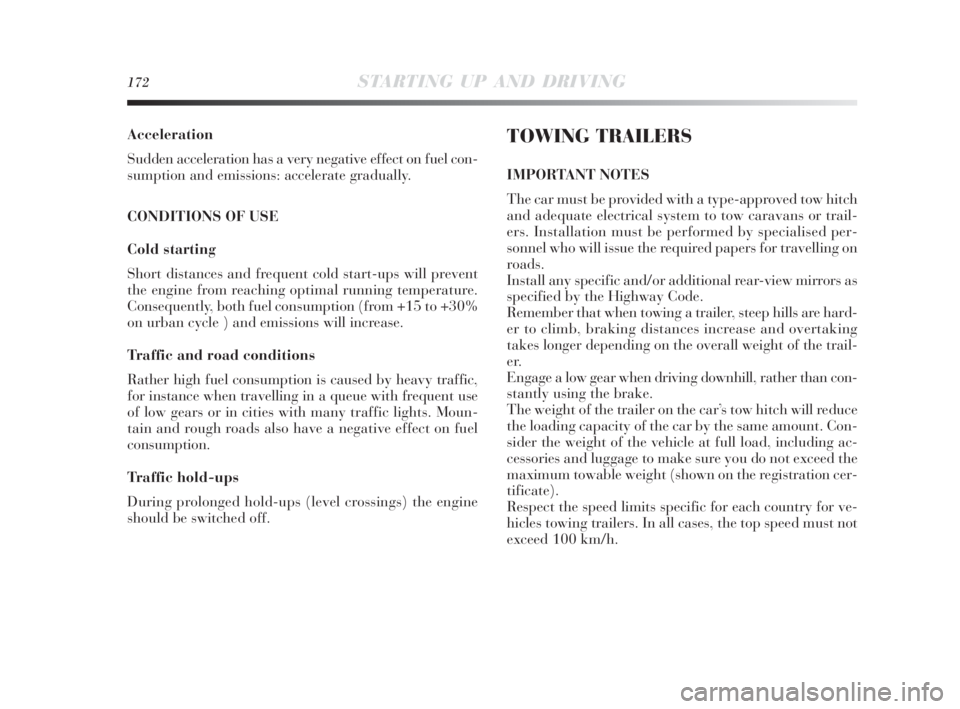
172STARTING UP AND DRIVING
Acceleration
Sudden acceleration has a very negative effect on fuel con-
sumption and emissions: accelerate gradually.
CONDITIONS OF USE
Cold starting
Short distances and frequent cold start-ups will prevent
the engine from reaching optimal running temperature.
Consequently, both fuel consumption (from +15 to +30%
on urban cycle ) and emissions will increase.
Traffic and road conditions
Rather high fuel consumption is caused by heavy traffic,
for instance when travelling in a queue with frequent use
of low gears or in cities with many traffic lights. Moun-
tain and rough roads also have a negative effect on fuel
consumption.
Traffic hold-ups
During prolonged hold-ups (level crossings) the engine
should be switched off.TOWING TRAILERS
IMPORTANT NOTES
The car must be provided with a type-approved tow hitch
and adequate electrical system to tow caravans or trail-
ers. Installation must be performed by specialised per-
sonnel who will issue the required papers for travelling on
roads.
Install any specific and/or additional rear-view mirrors as
specified by the Highway Code.
Remember that when towing a trailer, steep hills are hard-
er to climb, braking distances increase and overtaking
takes longer depending on the overall weight of the trail-
er.
Engage a low gear when driving downhill, rather than con-
stantly using the brake.
The weight of the trailer on the car’s tow hitch will reduce
the loading capacity of the car by the same amount. Con-
sider the weight of the vehicle at full load, including ac-
cessories and luggage to make sure you do not exceed the
maximum towable weight (shown on the registration cer-
tificate).
Respect the speed limits specific for each country for ve-
hicles towing trailers. In all cases, the top speed must not
exceed 100 km/h.
165-174 Delta 3ed gb 11-11-2009 12:10 Pagina 172
Page 189 of 276

188IN AN EMERGENCY
Taking out the small spare wheel
Important notes:
❍the jack weight is 1.76 kg;
❍the jack requires no adjustment;
❍the jack cannot be repaired; If it breaks it must be re-
placed with a new jack;
❍no tool other than the cranking device may be fitted
on the jack.
To replace a tyre proceed as follows:
❍stop the car in a position where it does not present a
danger for on-coming traffic and where you can re-
place the wheel safely. The ground must be flat and
compact;
❍turn the engine off and engage the handbrake;
❍engage first gear or reverse;
❍lift up the luggage compartment mat using handle A-
fig. 10 (in the presence of a double load platform, first
lift the upper cover and then the luggage compartment
mat);
❍loosen the fastener B-fig. 10;
❍take out the tool box C and place it next to the wheel
to be changed;
❍remove the small spare wheel D-fig. 10;
❍use the provided screwdriver to remove the hub cap,
levering the dedicated opening on the outer edge;
fig. 10L0E0081m
175-214 Delta 4ed gb 24-02-2010 14:36 Pagina 188
Page 244 of 276
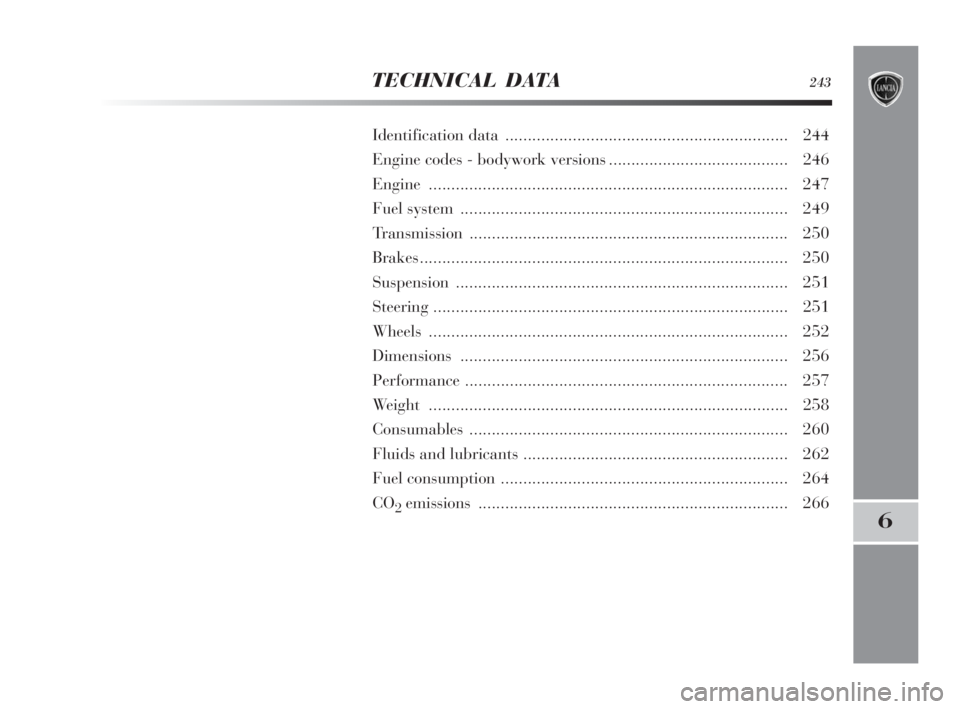
TECHNICAL DATA243
6
Identification data ............................................................... 244
Engine codes - bodywork versions........................................ 246
Engine ................................................................................ 247
Fuel system ......................................................................... 249
Transmission ....................................................................... 250
Brakes.................................................................................. 250
Suspension.......................................................................... 251
Steering ............................................................................... 251
Wheels ................................................................................ 252
Dimensions......................................................................... 256
Performance ........................................................................ 257
Weight ................................................................................ 258
Consumables ....................................................................... 260
Fluids and lubricants........................................................... 262
Fuel consumption................................................................ 264
CO
2emissions..................................................................... 266
243-266 Delta 3ed gb 11-11-2009 12:16 Pagina 243